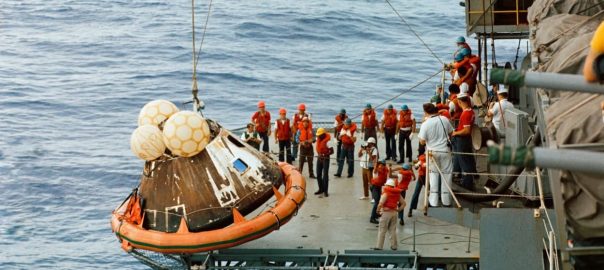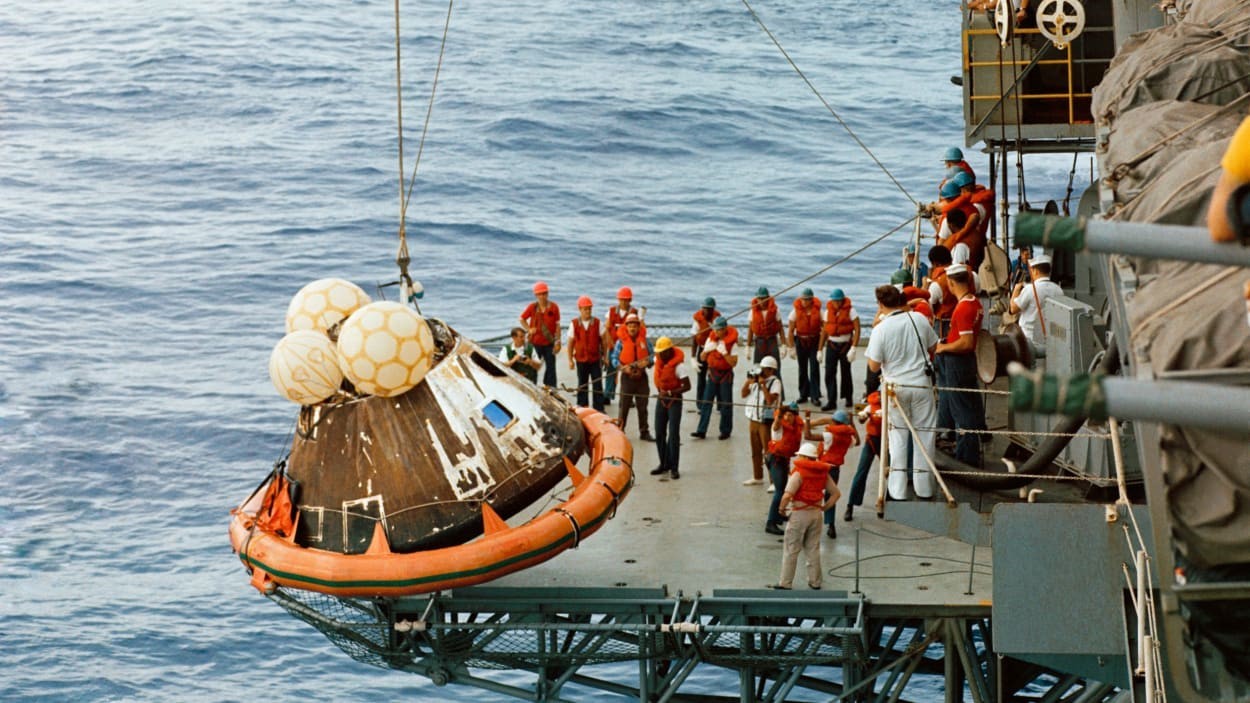My younger executive coaching clients usually know nothing about the Apollo 13 rescue. Older clients know of it, but few know the details. Yet the story offers us fresh insights into what it takes to build high-performing teams.
The BBC radio series, 13 Minutes To The Moon, created by Kevin Fong and Andrew Luck-Baker, offers an in-depth look into the six dramatic days in 1970 when NASA’s Mission Control teams in Houston repeatedly displayed a principle all teams should embrace. I call it shared leadership.
The story
Apollo 13 blasted off from Kennedy Space Center with a three-man crew on April 11, 1970. Its mission? To land on the moon, gather geological, scientific, and survival data, and return to Earth safely.
It soon sped up to 25,000 mph and left the Earth’s orbit. After two days, it was 200,000 miles from Earth, heading towards the moon. Then, 56 hours into the flight, an oxygen tank exploded in the service unit behind the Command Module containing the three astronauts. It blew an aluminum panel off the side of the spacecraft, exposing part of its interior to space. But neither the crew nor the mission control teams knew that. All the crew could see and feel were alarms flashing, needles on dials flickering, and Apollo 13 rocking and swaying in space. Nobody in Houston knew if this was a genuine problem or whether failing sensors were relaying false data.
Crisis after crisis unfolded over the next four days. The mission was facing catastrophe. It looked like the three astronauts wouldn’t make it back to Earth.
Keeping the ground and in-space teams united and successful across huge distances in such devastating, confusing circumstances was tough. If the team members had lost confidence and trust in one another, or self-discipline, disaster would have followed. But it didn’t. Despite facing an avalanche of energy-sapping crises, the crew made it back alive. Teamwork saved the day.
Shared leadership
NASA is a civil organization with military roots. You’d think its heritage and the severity of Apollo 13’s crisis would mean you’d see a command-and-control approach in the face of so many emergency decisions. But you’d be wrong. Instead, we saw mission control display repeated examples of shared leadership.
For me, leadership isn’t a person, nor an office, nor a job title, nor a group of people. Instead, it’s a process. By “process,” I mean a series of choices and actions around defining and achieving a goal. Leadership is the process of paying attention to four dimensions: motivating purpose, task progress and results, group unity, and attention to individuals.
When you see leadership as a four-dimensional process you realize “leadership” and “the leader” aren’t identical. Instead, leaders serve the process of addressing all four dimensions, meaning the challenge of leadership is bigger than the role of one specific person.
That’s when you realize that any team member driving progress in one or more dimensions is contributing leadership behavior. Thus, every team member, not just the leader, can exert leadership. So, teams can share leadership. But not only can they, they must if they’re to feel the commitment, initiative, and joint accountability that makes a group of people a genuine team.
Shared leadership recognises that team leaders cannot do it all and that their teammates must share the burden. About 53 years ago, the teams in Mission Control in Houston displayed shared leadership superbly. Here are six examples:
Crucial question
As captured by the BBC, in the minutes after the explosion, confusion reigned in mission control. Everyone was coming to Gene Kranz, flight director of the first team on shift, the White team, with theories and ideas. No one knew which data was correct or not. Then CAPCOM, who reported to Kranz, the only person allowed to speak to the crew, asked, “Flight, is there anything solid or reliable we can trust?” Kranz realized he had to change tack. He posed the question to his teammates, “What have we got on the spacecraft that’s good?” The atmosphere changed immediately.
Look at how CAPCOM took the lead skilfully by asking a question. He shared leadership in that moment with Kranz. And Kranz allowed it.
Cutting power
Within hours, NASA realized Apollo 13 would soon run out of power and they’d lose the crew.
Sy Liebergot, another of Kranz’s direct reports, ran the EECOM team looking after the spacecraft’s electrical and environmental systems. He, like every other flight controller, had his own team elsewhere in the building. Dick Brown, one of his team members, told Liebergot, “We must save power. We need to start switching off equipment in the command and service modules.” Liebergot passed the message to Kranz, telling him they need to reduce power by 10 amps, a huge cut. Kranz was shocked but accepted Liebergot and Brown’s advice. He told CAPCOM to tell the crew.
Dick Brown shared leadership. He didn’t worry about hierarchy or job titles in that moment. He led by pointing out that they must save power, starting now. And again, Kranz supported him.
The lifeboat
The Black team, headed by Glynn Lunney, had just come on shift. Meanwhile, Apollo 13 was losing power faster than expected. Within minutes, Merlin Merritt, the new Black team EECOM, approached Lunney and declared forcefully, “It’s obvious we’ll have to fire up the lunar module to make it a safe lifeboat for the crew.” (Note: NASA designed the lightweight disposable lunar module for landing and taking off from the moon, nothing more.) On hearing that, Lunney asked his newly on-shift team, “Are there any other options?” “No,” was the answer from all flight controllers.
Again, when Merlin Merritt intervened, we saw shared leadership in action.
Survival
The crew were speeding back to Earth in the lunar module with the command and service module attached. NASA designed the lunar module to support two people for two days. Now it had to serve three people for three-and-a-half days. But it only had enough power for one-and-a-half days.
Merlin Merritt asserted himself again. Taking off his headset and walking over to Lunney he said, “We must preserve power on the lunar module if the crew are to survive. That means turning off almost everything, including its guidance equipment.” Lunney agreed.
Once more, Merritt took the lead, and his leader was comfortable with it. Again, shared leadership.
Course correction
Hours later, with the Gold team on shift, Apollo 13 was limping back to earth but moving too slowly for the limited, dwindling power supply.
Four flight controllers in the “Trench,” the front row of consoles in the Mission Control room, came forward to recommend a four-and-a-half minute engine burn to quicken progress. They argued this would cut the arrival time by 10 hours. However, NASA hadn’t designed the lunar module’s engines for a burn like this. It was risky. Gerry Griffin, Gold team leader, deferred to their know-how. The maneuver worked.
In this case, four people combined to share leadership. They didn’t wait for their leader to seek ideas. They stepped in and offered leadership. And Griffin accepted it as natural.
Separating lunar and command modules
As Apollo 13 approached the Earth it was time to abandon the lunar module and return to the command module. Why? Because only the command module’s heat shields could protect the crew against the 5,000°F temperatures they would face in reentering the Earth’s atmosphere. Unfortunately, they couldn’t separate the two vehicles the usual way. The CM didn’t have a thruster engine and they couldn’t use the lunar module’s engines as they were about to abandon it.
But the four “Trench” flight controllers had foreseen the problem two days earlier and came up with a novel plan. It worked.
Another example of team members leading without being asked and the official leader following.
The Apollo 13 rescue showed that when we work in teams and view shared leadership as natural, our results can soar even under the most testing conditions.
(29)
Report Post






